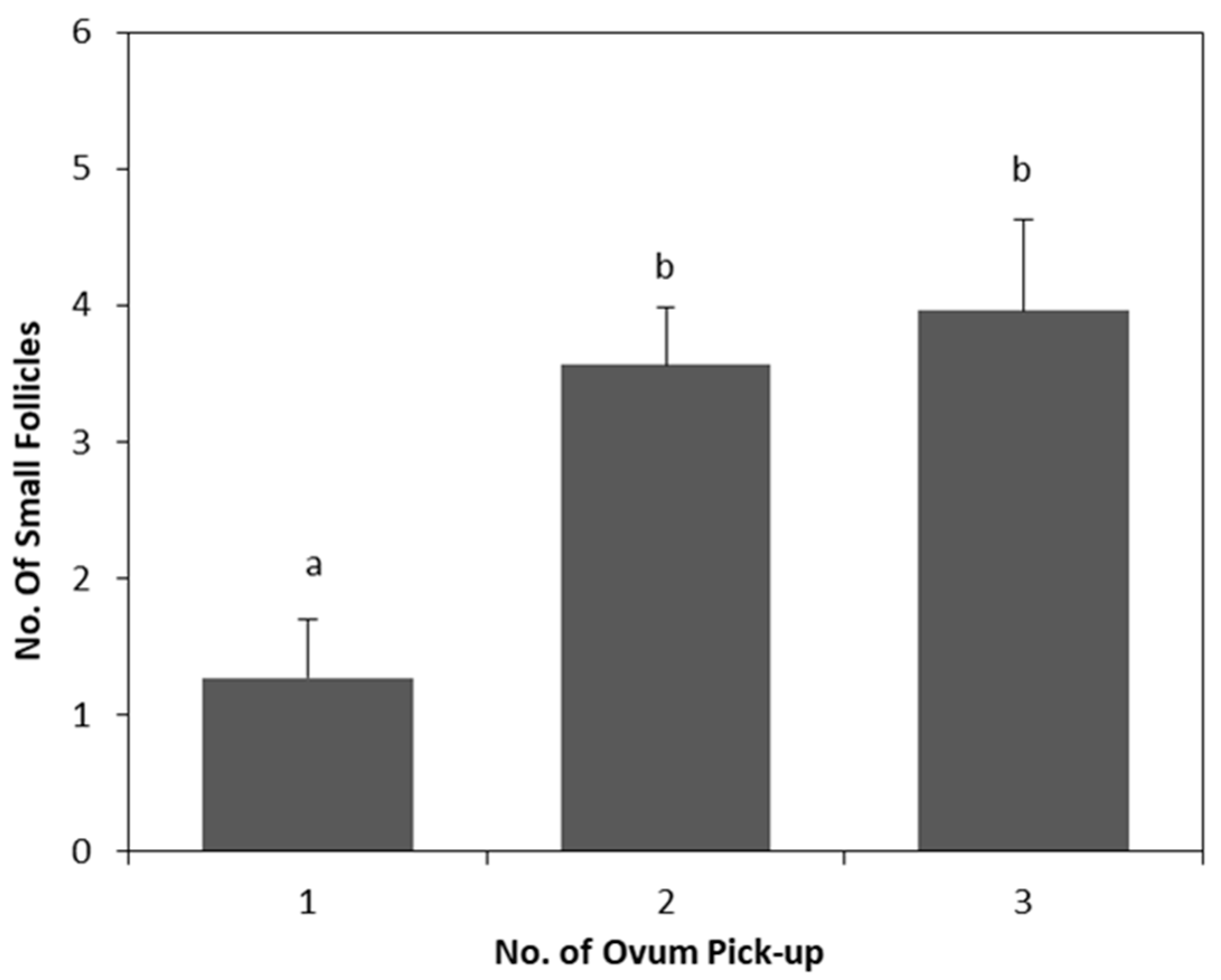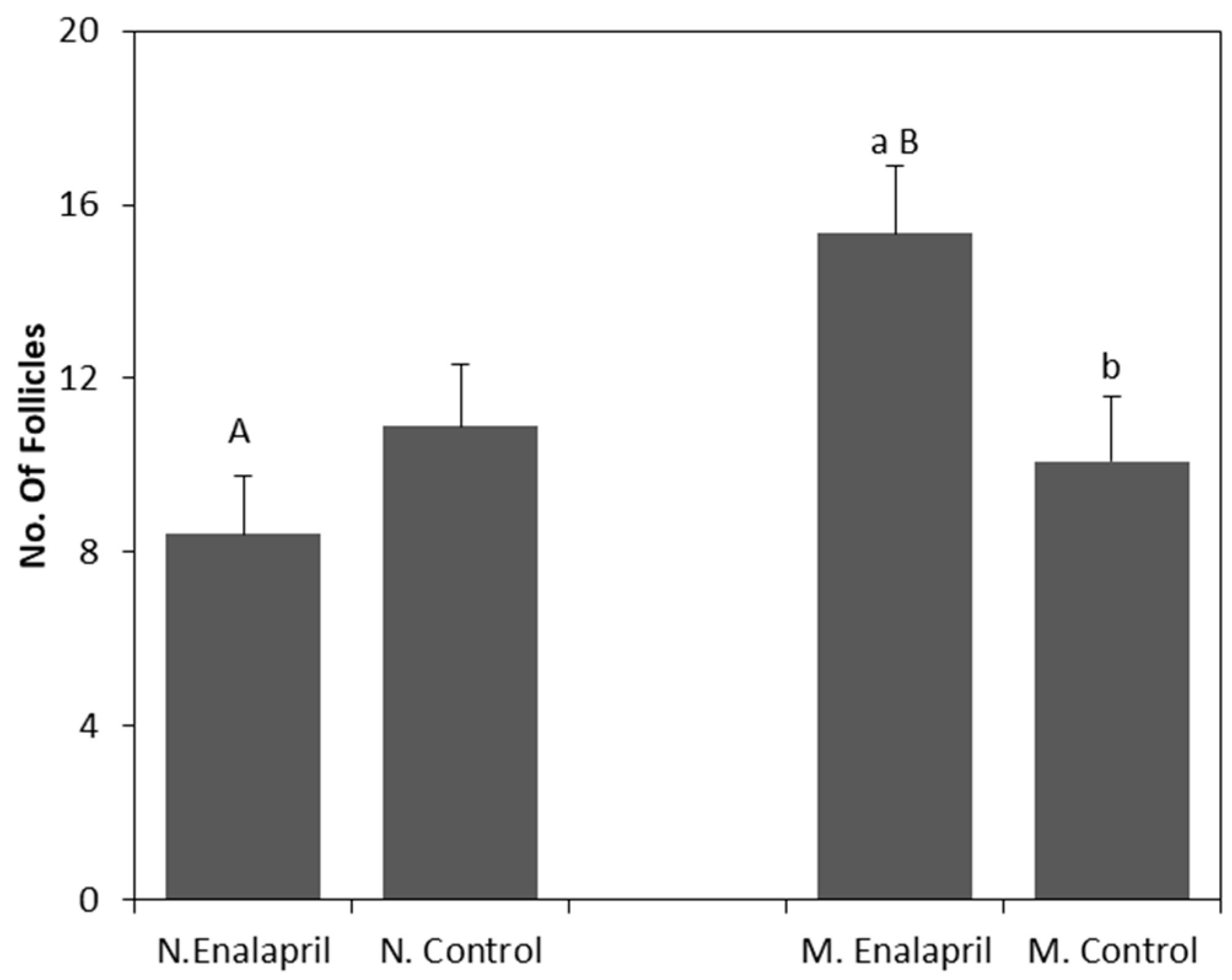Effect of Continuous Administration of Enalapril Maleate on the Oocyte Quality and In Vitro Production of Parthenote Embryos in Nulliparous and Multiparous Goats Undergoing Serial Laparoscopic Ovum Pick-Up
Simple Summary
Abstract
1. Introduction
2. Materials and Methods
2.1. Location, Conditions, and Facilities
2.2. Animal Management
2.3. Experimental Design
2.4. Hormonal Treatment
2.5. Laparoscopic Ovum Pick-Up, Follicle Selection, and Oocyte Evaluation
2.6. In Vitro Maturation (IVM), Parthenogenetic Activation and In Vitro Culture (IVC)
2.7. Statistical Analysis
3. Results
4. Discussion
5. Conclusions
Author Contributions
Funding
Conflicts of Interest
References
- Cooper, C.A.; Maga, E.A.; Murray, J.D. Production of human lactoferrin and lysozyme in the milk of transgenic dairy animals: Past, present, and future. Transgenic Res. 2015, 24, 605–614. [Google Scholar] [CrossRef] [PubMed]
- Paramio, M.T.; Izquierdo, D. Recent advances in in vitro embryo production in small ruminants. Theriogenology 2016, 86, 152–159. [Google Scholar] [CrossRef] [PubMed]
- Baldassarre, H.; Rao, K.M.; Neveu, N.; Brochu, E.; Begin, I.; Behboodi, E.; Hockley, D.K. Laparoscopic ovum pick-up followed by in vitro embryo production for the reproductive rescue of aged goats of high genetic value. Reprod. Fertil. Dev. 2007, 19, 612–616. [Google Scholar] [CrossRef] [PubMed]
- Souza-Fabjan, J.M.G.; Locatelli, Y.; Freitas, V.J.F.; Mermillod, P. Laparoscopic ovum pick up (LOPU) in goats: From hormonal treatment to oocyte possible destinations. R. Bras. Ci. Vet. 2014, 21, 3–11. [Google Scholar] [CrossRef]
- Gibbons, A.; Pereyra, F.; Cueto, M.; Catala, M.; Salamone, D.; González-Bulnes, A. Procedure for maximizing oocyte harvest for in vitro embryo production in small ruminants. Reprod. Domest. Anim. 2007, 42, 423–426. [Google Scholar] [CrossRef]
- Avelar, S.R.G.; Moura, R.R.; Sousa, F.C.; Pereira, A.F.; Almeida, K.C.; Melo, C.H.S.; Teles-Filho, A.C.A.; Baril, G.; Melo, L.M.; Teixeira, D.I.A.; et al. Oocyte production and in vitro maturation in Canindé goats following hormonal ovarian stimulation. Anim. Reprod. 2012, 9, 1–7. [Google Scholar]
- Beckers, J.F.; Baril, G.; Vallet, J.C.; Chupin, D.; Remy, B.; Saumande, J. Are porcine follicle stimulating hormone antibodies associated with decreased superovulatory response in goat? Theriogenology 1990, 33, 192. [Google Scholar] [CrossRef]
- Remy, B.; Baril, G.; Vallet, J.C.; Dufour, R.; Chouvet, C.; Saumande, J.; Chupin, D.; Beckers, J.F. Are antibodies responsible for a decreased superovulatory response in goats which have been treated repeatedly with porcine follicle stimulating hormone? Theriogenology 1991, 36, 389–399. [Google Scholar] [CrossRef]
- Gibbons, A.; Pereyra, F.; Cueto, M.I.; Salamone, D.; Catala, M. Recovery of sheep and goat oocytes by laparoscopy. Acta Sci. Vete. 2008, 36, 223–230. [Google Scholar]
- Sanchez, D.J.D.; Melo, C.H.S.; Souza-Fabjan, J.M.G.; Sousa, F.C.; Rocha, A.A.; Campelo, I.S.; Teixeira, D.I.A.; Pereira, A.F.; Melo, L.M.; Freitas, V.J.F. Repeated hormonal treatment and laparoscopic ovum pick-up followed by in vitro embryo production in goats raised in the tropics. Livest. Sci. 2014, 165, 217–222. [Google Scholar] [CrossRef]
- Costa, A.S.; Junior, A.S.; Viana, G.E.N.; Muratori, M.C.S.; Reis, A.M.; Costa, A.P.R. Inhibition of Angiotensin-Converting Enzyme increases oestradiol production in ewes submitted to oestrus synchronization protocol. Reprod. Domest. Anim. 2014, 49, 53–55. [Google Scholar] [CrossRef] [PubMed]
- Fernandes Neto, V.P.; Silva, M.N.N.; Costa, A.S. ACE inhibition in goats under fixed-time artificial insemination protocol increases the pregnancy rate and twin births. Reprod. Domest. Anim. 2018, 00, 1–3. [Google Scholar] [CrossRef] [PubMed]
- Skinner, S.L.; Lumbers, E.R.; Symonds, E.M. Renin concentration in human fetal and maternal tissues. Am. J. Obstet. Gynecol. 1968, 101, 529–533. [Google Scholar] [CrossRef]
- Eskildsen, P.C. Renin in different tissues, amniotic fluid and plasma of pregnant and non-pregnant rabbits. Acta Pathol Microbiol Scand. A 1973, 81, 263–268. [Google Scholar] [CrossRef]
- Feitosa, L.C.S.; Viana, G.E.N.; Reis, A.M.; Costa, A.P.R. Sistema Renina Angiotensina Ovariano. Rev. Bras. de Reprod. Anim. 2010, 34, 243–251. [Google Scholar]
- Costa, A.P.R.; Fagundes-Moura, C.R.; Pereira, V.M.; Silva, L.F.; Vieira, M.A.; Santos, R.A.; Dos Reis, A.M. Angiotensin-(1-7): A novel peptide in the ovary. Endocrinology 2003, 144, 1942–1948. [Google Scholar] [CrossRef]
- Viana, G.E.N.; Pereira, V.M.; Honorato-Sampaio, K.; Oliveira, C.A.; Santos, R.A.S.; Reis, A.M. Angiotensin-(1–7) induces ovulation and steroidogenesis in perfused rabbit ovaries. Exp. Physiol. 2011, 96, 957–965. [Google Scholar] [CrossRef]
- Brosnihan, K.B.; Neves, L.A.A.; Anton, L.; Joyner, J.; Valdes, G.; Merrill, D.C. Enhanced expression of Ang-(1–7) during pregnancy. Braz. J. Med. Biol. Res. 2004, 37, 1255–1262. [Google Scholar] [CrossRef]
- Yoshimura, Y. The ovarian renin–angiotensin system in reproductive physiology. Front. Neuroendocrinol. 1997, 18, 247–291. [Google Scholar] [CrossRef]
- Morand-Fehr, P. Nutrition and feeding of goats: Applications to temperate climatic conditions. In Goat Production; Gall, C., Ed.; Academic Press: London, UK, 1981; pp. 193–232. [Google Scholar]
- NRC—National Research Council. Nutrient Requirements of Small Ruminants: Sheep, Goats, Cervids, and New World Camelids; National Academy of Sciences: New York, NY, USA, 2007. [Google Scholar]
- Baldassarre, H.; Wang, B.; Kafidi, N.; Gauthier, M.; Neveu, N.; Lapointe, J.; Sneek, L.; Leduc, M.; Duguay, F.; Zhou, J.F.; et al. Production of transgenic goats by pronuclear microinjection of in vitro produced zygotes derived from oocytes recovered by laparoscopy. Theriogenology 2003, 56, 831–839. [Google Scholar] [CrossRef]
- Speth, R.C.; Husain, A. Distribution of angiotensin-converting enzyme and angiotensin II-receptor binding sites in the rat ovary. Biol. Reprod. 1988, 38, 695–702. [Google Scholar] [CrossRef] [PubMed]
- Brentjens, J.R.; Matsuo, S.; Andres, G.A.; Caldwell, P.R.; Zamboni, L. Gametes contain angiotensin converting enzyme (kininase II). Experimentia 1986, 42, 399–402. [Google Scholar] [CrossRef] [PubMed]
- Pereira, A.M.; De Souza Júnior, A.; Machado, F.B.; Gonçalves, G.K.; Feitosa, L.C.; Reis, A.M.; Santos, R.A.; Honorato-Sampaio, K.; Costa, A.R. The effect of angiotensin-converting enzyme inhibition throughout a superovulation protocol in ewes. Res. Vet. Sci. 2015, 103, 205–210. [Google Scholar] [CrossRef] [PubMed]
- Nielsen, A.H.; Schauser, K.H.; Svenstrup, B.; Poulsen, K. Angiotensin Converting Enzyme in Bovine Ovarian Follicular Fluid and its Relationship with Oestradiol and Progesterone. Reprod. Domest. Anim. 2002, 37, 81–85. [Google Scholar] [CrossRef] [PubMed]
- Obermüller, N.; Gentili, M.; Gauer, S.; Gretz, N.; Weigel, M.; Geiger, H.; Gassler, N. Immunohistochemical and mRNA Localization of the Angiotensin II Receptor Subtype 2 (AT2) in Follicular Granulosa Cells of the Rat Ovary. J. Histochem. Cytochem. 2004, 52, 545–548. [Google Scholar] [CrossRef] [PubMed]
- Kuhholzer, B.; Brem, G. In vivo development of micro injected embryos from superovulated prepuberal slaughter lambs. Theriogenology 1999, 51, 1297–1302. [Google Scholar] [CrossRef]
- Mellado, M.; Olivas, R.; Ruiz, F. Effect of buck stimulus on mature and pre- pubertal norgestomet-treated goats. Small Rumin. Res. 2000, 36, 269–274. [Google Scholar] [CrossRef]
- Driancourt, M.A.; Avdi, M. Effect of the physiological stage of the ewe on the number of follicles ovulating following hCG injection. Anim. Reprod. Sci. 1993, 32, 227–236. [Google Scholar] [CrossRef]
- Quirke, J.F.; Hanrahan, J.P. Comparison of the survival in the uteri of adult ewes of cleaved ova from adult ewes and ewe lambs. J. Reprod. Fertil. 1977, 51, 487–489. [Google Scholar] [CrossRef]
- Rangel-Santos, R.; Mcdonald, M.F.; Wickham, G.A. Evaluation of the feasibility of a juvenile MOET scheme in sheep. Proc. N. Z. Soc. Anim. Prod. 1991, 51, 139–142. [Google Scholar]
- Baldassarre, H.; Wang, B.; Kafidi, N.; Keefer, C.; Lazaris, A.; Karatzas, C.N. Advances in the production and propagation of transgenic goats using laparoscopic ovum pick-up and In vitro embryo production technologies. Theriogenology 2002, 57, 275–284. [Google Scholar] [CrossRef]
- Baril, G.; Remy, B.; Vallet, J.C.; Beckers, J.F. Effect of repeated use of progestagen-PMSG treatment for estrus control in dairy goats out of breeding season. Reprod. Domest. Anim. 1992, 27, 161–168. [Google Scholar] [CrossRef]
- Cognie, Y.; Poulin, N.; Locatelli, Y.; Mermillod, M. State-of-the-art production, conservation and transfer of in vitro-produced embryos in small ruminants. Reprod. Fertil. Dev. 2004, 16, 437–445. [Google Scholar] [CrossRef] [PubMed]
- Hasler, J.F. Current status and potential of embryo transfer and reproductive technology in dairycattle. J. Dairy Sci. 1992, 75, 2857–2879. [Google Scholar] [CrossRef]
- Lehloenya, K.C.; Greyling, J.P.C. The ovarian response and embryo recovery rate in Boer goats does following different superovulation protocols, during the breeding season. Small Rumin. Res. 2010, 88, 38–43. [Google Scholar] [CrossRef]
- Lopes Jr, E.S.; Maia, E.L.M.M.; Paula, N.R.O.; Teixeira, D.I.A.; Villarroel, A.B.S.; Rondina, D.; Freitas, V.J.F. Effect of age of donor on embryo production in Morada Nova (white variety) ewes participating in a conservation programme in Brazil. Trop. Anim. Hlth. Prod. 2006, 38, 555–561. [Google Scholar]
- Su, L.; Yang, S.; He, X.; Li, X.; Ma, J.; Wang, Y.; Presicce, G.A.; Ji, W. Effect of donor age on the developmental competence of bovine oocytes retrieved by ovum pick up. Reprod. Domest. Anim. 2012, 47, 184–189. [Google Scholar] [CrossRef]




| Attributes | Treatment | p-Value | ||||||
|---|---|---|---|---|---|---|---|---|
| Control | Enalapril Maleate | Mean | Treatment | Group | No. LOPU | T vs. G | T vs. L | |
| No. of goats exposed | 10 | 10 | ||||||
| Ovarian response | ||||||||
| Small Follicles, n | 3 ± 0.4 | 3 ± 0.4 | 3 ± 0.3 | 0.55 | 0.09 | 0.01 | 0.21 | 0.85 |
| Medium Follicles, n | 4 ± 0.9 | 5 ± 0.9 | 5 ± 0.6 | 0.46 | 0.16 | 0.06 | 0.10 | 0.50 |
| Large Follicles, n | 3 ± 0.7 | 4 ± 0.7 | 4 ± 0.3 | 0.31 | 0.86 | 0.73 | 0.01 | 0.47 |
| Total Follicles, n | 10 ± 1.3 | 12 ± 1.2 | 11 ± 0.8 | 0.22 | 0.11 | 0.63 | 0.01 | 0.33 |
| Attributes | Treatment | p-Value | ||||||
|---|---|---|---|---|---|---|---|---|
| Control | Enalapril Maleate | Mean | Treatment | Group | No. LOPU | T vs. G | T vs. L | |
| No. of goats exposed | 10 | 10 | ||||||
| Oocyte and embryo | ||||||||
| Viable oocytes, n | 7 ± 1.1 | 7 ± 1.0 | 7 ± 0.6 | 0.50 | 0.43 | 0.76 | 0.07 | 0.27 |
| Degenerate oocyte, n | 1 ± 0.4 | 1 ± 0.4 | 1 ± 0.2 | 0.35 | 0.25 | 0.04 | 0.87 | 0.53 |
| Recovery rate, % (n/n) | 75.6 (167/221) | 62.2 (153/246) | 66.4 (320/467) | 0.54 | 0.71 | 0.73 | 0.18 | 0.20 |
| Embryo, n | 5 ± 0.9 | 5 ± 0.9 | 5 ± 0.9 | 0.15 | 0.11 | 0.52 | 0.53 | 0.27 |
| Cleavage rate, % (n/n) | 59.3 (99/167) | 71.9 (110/153) | 65.6 (209/320) | 0.05 | 0.30 | 0.72 | 0.77 | 0.21 |
© 2019 by the authors. Licensee MDPI, Basel, Switzerland. This article is an open access article distributed under the terms and conditions of the Creative Commons Attribution (CC BY) license (http://creativecommons.org/licenses/by/4.0/).
Share and Cite
Bravo, P.A.; Moreno, M.E.; Fernandes, C.C.L.; Rossetto, R.; Cavalcanti, C.M.; Fernandes, D.P.; Rondina, D. Effect of Continuous Administration of Enalapril Maleate on the Oocyte Quality and In Vitro Production of Parthenote Embryos in Nulliparous and Multiparous Goats Undergoing Serial Laparoscopic Ovum Pick-Up. Animals 2019, 9, 868. https://doi.org/10.3390/ani9110868
Bravo PA, Moreno ME, Fernandes CCL, Rossetto R, Cavalcanti CM, Fernandes DP, Rondina D. Effect of Continuous Administration of Enalapril Maleate on the Oocyte Quality and In Vitro Production of Parthenote Embryos in Nulliparous and Multiparous Goats Undergoing Serial Laparoscopic Ovum Pick-Up. Animals. 2019; 9(11):868. https://doi.org/10.3390/ani9110868
Chicago/Turabian StyleBravo, Pamela A., Maria E. Moreno, César C.L. Fernandes, Rafael Rossetto, Camila M. Cavalcanti, Denilsa P. Fernandes, and Davide Rondina. 2019. "Effect of Continuous Administration of Enalapril Maleate on the Oocyte Quality and In Vitro Production of Parthenote Embryos in Nulliparous and Multiparous Goats Undergoing Serial Laparoscopic Ovum Pick-Up" Animals 9, no. 11: 868. https://doi.org/10.3390/ani9110868
APA StyleBravo, P. A., Moreno, M. E., Fernandes, C. C. L., Rossetto, R., Cavalcanti, C. M., Fernandes, D. P., & Rondina, D. (2019). Effect of Continuous Administration of Enalapril Maleate on the Oocyte Quality and In Vitro Production of Parthenote Embryos in Nulliparous and Multiparous Goats Undergoing Serial Laparoscopic Ovum Pick-Up. Animals, 9(11), 868. https://doi.org/10.3390/ani9110868





